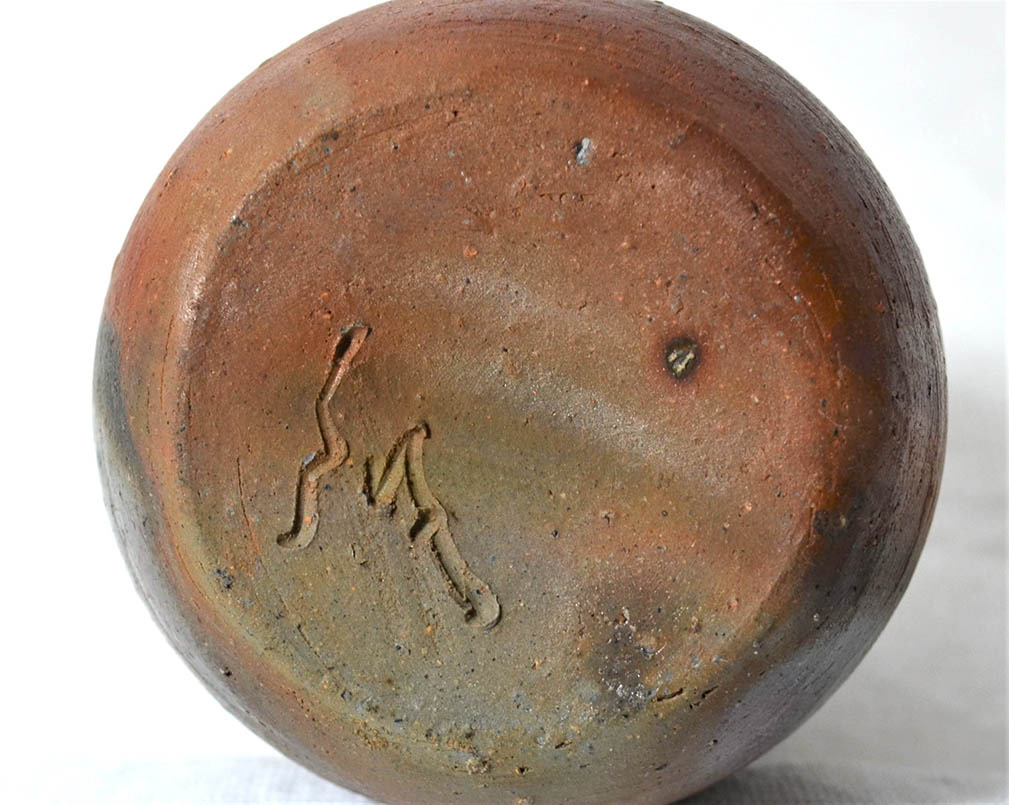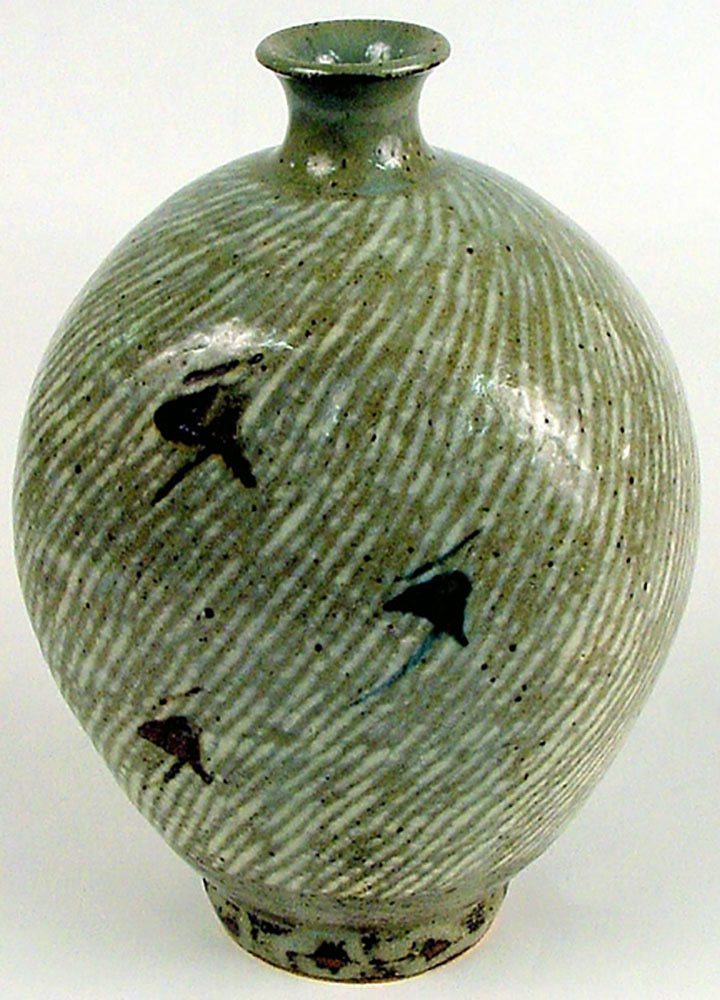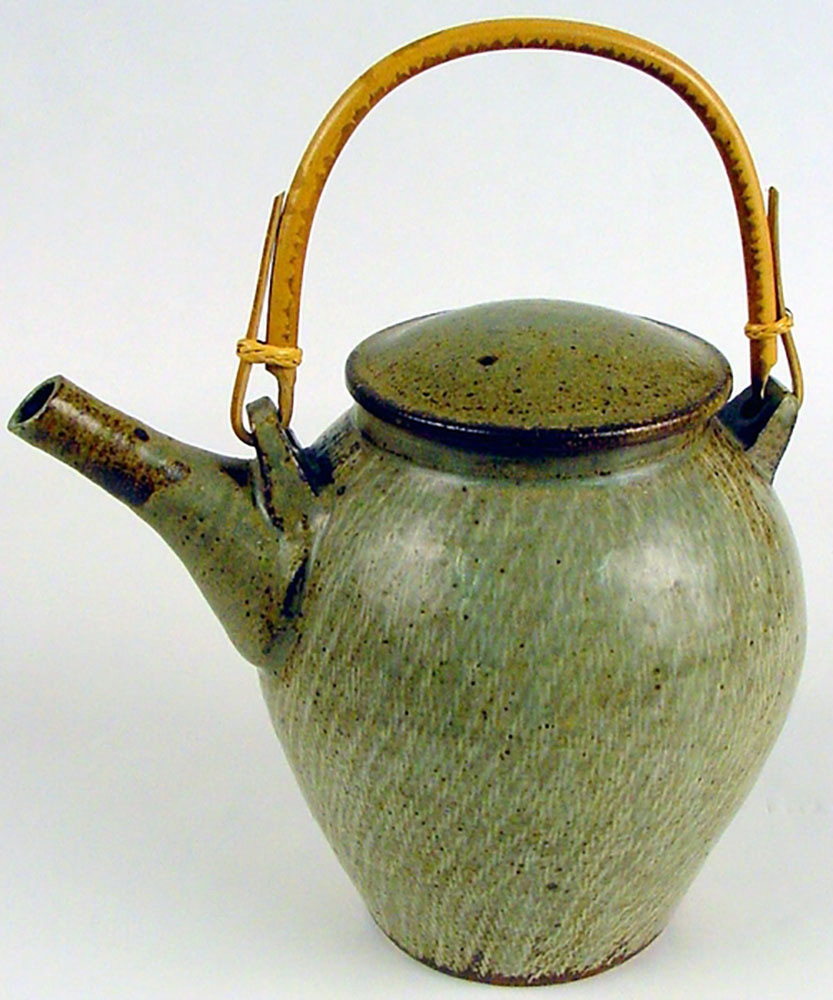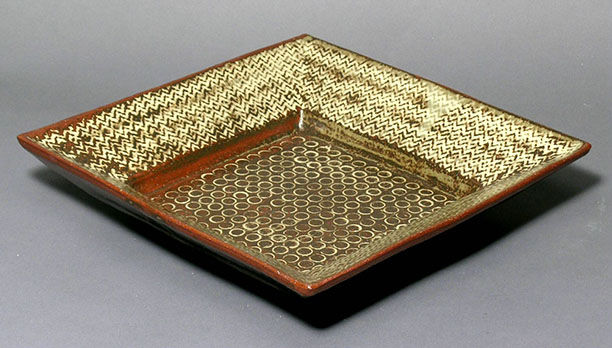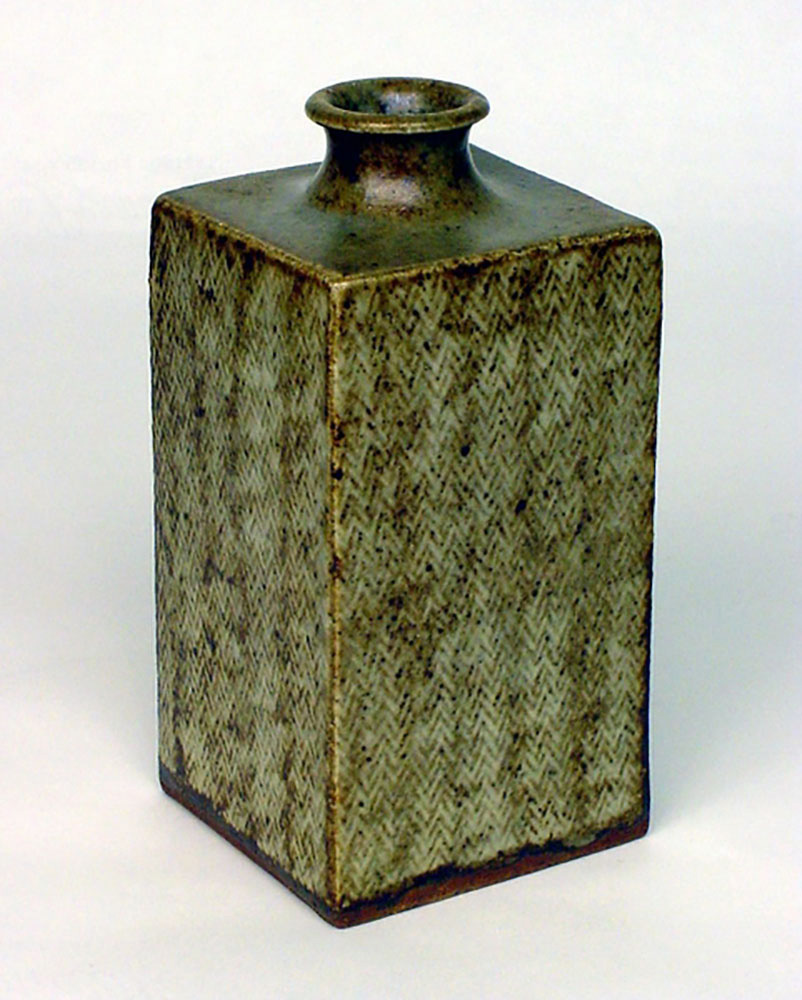Intangible Treasures
Tangible goods are things we can touch, that have form or shape. Intangible objects are things we cannot grasp physically, such as knowledge or special techniques passed down from artist to artist. Japan was the first country to enact laws to protect Important Intangible Cultural Property, starting in 1950, with the intention to preserve important traditions like theater, dance, and ceramic art techniques that might otherwise be lost. Early on, newspapers coined the term, “Living National Treasure,” for the designation. However, it is not an award, but rather a distinction that comes with great responsibility. In the Morikami Museum Collection, we have works representing several Important Intangible Cultural Property (IICP) recipients, as well as their descendants, students, and contemporaries.
Hamada
Hamada Shōji (1894-1978) was one of the first potters to receive the designation in 1955. He was responsible for preserving the Mashiko ware style, named after the town where it was first produced. Once he settled in Mashiko and created his own studio compound around 1926, he and others like Kawai Kanjirō (1890-1966) and Yanagi Sōetsu (1889-1961) founded the influential Mingei movement, which sought to elevate the role of the humble artisans of everyday handmade objects to a level equal with fine artists.
In Hamada’s own words, “I found the path in Kyoto, began my journey in England, studied in Okinawa, and developed in Mashiko.”
Sake bottle and cup
By Hamada Shōji (1894-1978)
Showa period, ca. 1960-1977
Glazed stoneware
Bottle 5.5”h and cup 2.875”h
Gift of Josephine Aiko Onodera and Misha & June Rudolph
2002.001.004a-d
This square bottle made by combining slabs of clay is a frequent shape used by Hamada.
Square bottle
By Hamada Shōji (1894-1978)
Shōwa period, ca. 1965
Stoneware with iron glaze
9.5”h x 4”w
Museum Purchase funded by Members of the Wisdom Ring,
2017.001.002
Fujiwara & Nakazato
Fujiwara Kei (1899-1993) and Nakazato (Muan) Tarōemon XII (1895-1985) were recipients of the title in 1970 and 1976, respectively. Fujiwara went to Tokyo aspiring to be a poet, but after falling ill, he found himself studying Bizen wares back in his hometown. Nakazato, on the other hand, helped to revive the Karatsu ware tradition – known for iron underglaze decoration introduced from the Korean peninsula in the 15th century. The Nakazato family has an unbroken lineage of 14 generations.
Bizen wares like this one are usually quite rough in texture and unglazed to highlight the natural clay body.
Sake bottle and cup
Attributed to Fujiwara Kei (1899-1993)
Shōwa period, ca. 1970s
Stoneware with ash glaze
Bottle 4.5”h and cup 2.5”h
Gift of S. Jerry Hirschberg
2001.023.001a-c
Nakazato ‘signed’ this work by painting three dots in a triangle pattern on the body with his fingers, and indenting three more dots on the base with a tool.
Tea bowl,
By Nakazato (Muan) Tarōemon XII (1895-1985)
Shōwa period, ca. 1965-1980
Stoneware with iron underglaze,
3”h x 4.75”w
Gift of Dr. Daphne Rosensweig
2014.018.001
Tamura & Imaizumi
In 1986, Tamura Kōichi (1918-1987) became an IICP for his preservation of tetsu-e, or pictorial underglaze decorations in iron oxide glaze. Items with underglaze go into the kiln once. Imaizumi Imaemon XIII (1926-2001) joined the ranks of IICP in 1989. He preserves iro-e jiki, or the colored overglaze enamel technique on porcelain (clay with a high portion of the mineral kaolin fired at very high temperatures). Overglazed objects go into the kiln plain; they are decorated, and then fired again at lower temperatures.
Tamura painted the persimmons on this vase with an iron oxide underglaze.
Vase
By Tamura Kōichi (1918-1987)
Shōwa period, ca. 1970-1980
Stoneware with underglaze iron decoration
7”h x 3.375”diam
Gift of Japan Foreign Ministry
1978.001.005a-b
On hard smooth porcelain, artists generally sign their works in glaze as seen here.
Plate
By Imaizumi Imaemon XIII (1926-2001)
Heisei period, ca. 1990-1998
Porcelain with cobalt blue underglaze and overglaze enamel decoration
1.25”h x 7”diam
Gift of Nancy Goerler
1998.001.001a-d
Shimaoka & Tokuda
Shimaoka Tatsuzō (1919-2007) was a student of Hamada Shōji. He received his designation in 1996, but the method he preserves called, jōmon, meaning “rope mark” is more than 10,000 years old. The technique creates repetitive patterns by pressing cords into soft clay. Tokuda Yasokichi III (1933-2009) was recognized in 1997 for Saiyū type Kutani wares, which feature brightly colored glazes over porcelain. Yasokichi III perfected the glazing techniques that his grandfather and father worked so hard to revive. Today, his daughter is carrying on the family lineage.
This vase is decorated with rope markings and then a slip (clay mixed with water to make it a liquid) fills in the cracks to create the green and white design. Other glazes are painted on to make the dark shapes on the body and foot.
Vase
By Shimaoka Tatsuzō (1919-2007)
Shōwa period, ca. 1970-1980
Stoneware with iron oxide and cobalt underglaze decoration
9.5”h x 7”diam
Gift of Japan Foreign Ministry
1978.001.007a-b
This jug used for pouring sake has a bamboo handle.
Jug
By Shimaoka Tatsuzō (1919-2007)
Shōwa period, ca. 1970s
Glazed stoneware with pressed cord patterns
8.75”h x 4.75”diam
Museum Purchase
1980.009.001a-b
Not only ropes but also other implements–such as a small tube–can be used to press circular patterns into unfired clay.
Square dish
By Shimaoka Tatsuzō (1919-2007)
Shōwa period, ca. 1970s
Glazed stoneware with pressed cord patterns
2.5”h x 11”w x 11”d
Museum Purchase funded by Friends of the Museum
1981.010.008a-b
Notice the form of this vase is the same as the one produced by his teacher (image 2) Hamada Shōji.
Square vase
By Shimaoka Tatsuzō (1919-2007)
Shōwa period, ca. 1970s
Glazed stoneware with pressed cord patterns
7.25”h x 3.5”w
Gift of Mr. & Mrs. Joseph Hayslip
1989.003.009
Because porcelain requires very high temperatures for firing, only certain glazes – like cobalt blue – can survive the process, which limits the possible color pallet.
Long-necked vase
By Tokuda Yasokichi III (1933-2009)
Late Shōwa period, 1984
Glazed porcelain
10.5”h x 5”diam
Gift of Mr. & Mrs. Michael Marcus
1995.018.158
Both Shimaoka’s and Tokuda’s works demonstrate the shift to a larger scale (more for show and less for function) that started in the 1990s.
Globular vase
By Tokuda Yasokichi III (1933-2009)
Early Heisei period, 1993
Glazed porcelain
9”h x 7.5”diam
Gift of Mr. & Mrs. Ron Ward
2007.025.001
Shimizu
Shimizu Yasutaka (b. 1947) is another artist in the Morikami Collection. He is the son of Shimizu Uichi (1926-2004) who received the IICP designation in 1985. Yasutaka’s work highlights thick, heavily textured glazes – a feature of the family studio. The technique they preserve is the decorative technique, tetsu gusuri, or iron overglaze.
This tea bowl features the yuteki, or “oil spot,” decoration, which is very difficult to achieve.
Tea bowl
By Shimizu Yasutaka (b. 1947)
Heisei period, ca. 1994-1998
Earthenware with ‘oil spot’ iron overglaze
6.5”h x 4.75”diam
Museum Purchase
2010.004.001
Although Yasutaka carries on the family traditions and is a likely candidate for nomination to the Important Intangible Cultural Property, it is not a hereditary title so there is no guarantee he will receive it.
Large vase
By Shimizu Yasutaka (b. 1947)
Heisei period, 1999
Glazed stoneware
12.5”h x 9.25”w
Gift in honor of Tom Gregersen
2013.004.001
Ohi
All of the recipients of the IICP exhibit with the Nihon Dentō Kōgei Ten (Japan Traditional Craft Exhibit). The other major group for ceramicists is the Nihon Bijustu Tenrankai (Japan Fine Arts Exhibition), or ‘Nitten.’ Ohi Chōzaemon XI (b. 1958) comes from a long line of award winning potters. Ohi visited the Morikami Museum in January of 2019 and donated two of his beautiful tea bowls.
To sign this work the artist added a disc of clay with his seal in raised relief.
Footed tea bowl
By Ohi Chōzaemon XI (b. 1958)
Heisei period, 2018
Porcelain with tri-color glaze
4.25”h x 6.25”diam
Gift of the Artist
2019.001.001a-b
The Ohi family’s distinctive ameyu, or amber glaze, creates a warm luster, which perfectly compliments the bright green of the powdered tea used in tea ceremonies.
Tea bowl
By Ohi Chōzaemon XI (b. 1958)
Heisei period, 2018
Glazed earthenware
3.5”h x 4.75”w
Gift of the Artist
2019.001.002a-b
We are fortunate to have a broad representation of fine Japanese ceramic artists in the Morikami Collection, as well as other works by IIICP recipients in lacquer ware, papermaking, and textile stencil dying. The treasure is the experience you get from viewing these amazingly beautiful and functional works of art.
Funded in part by PNC Art Alive, The Japan Foundation, New York / Center for Global Partnership and the Henri and Tomoye Takahashi Charitable Foundation.



